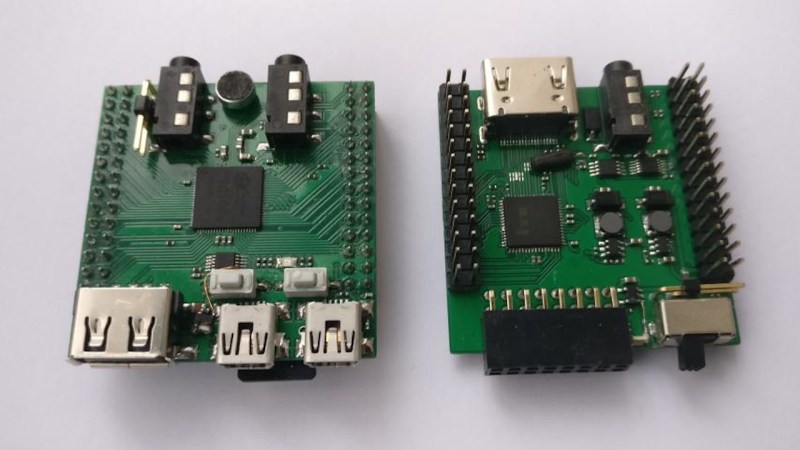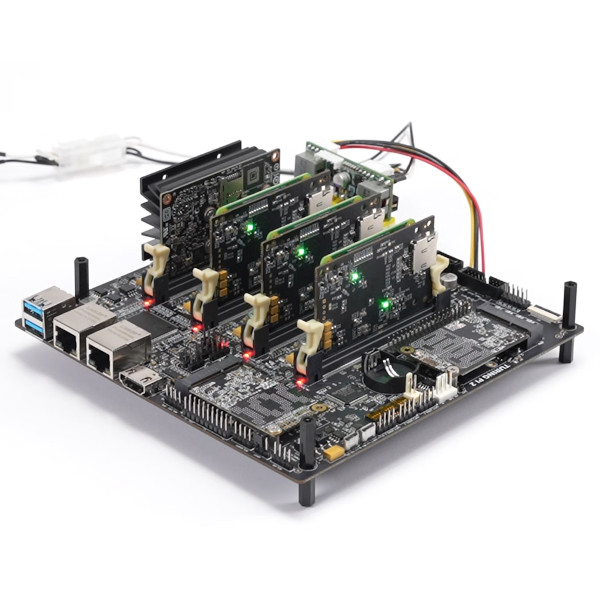The F1C100S (and the F1C200S) is a super simple CPU to use – it’s QFN, it has RAM built-in, and it can run Linux. It just makes sense that we bring it up to you once again, this time, on this dual-board computer by [minilogic]. The boards look super accessible to build for a Linux computer, and it’s alright if you assemble only one of them, too – the second board just makes this computer all that much nicer to use!
One the main board, you get the CPU itself, a couple USB ports, headphone and mic jacks, a microphone, a microSD socket, power management, SPI flash chip, plus some buttons, headers and USB-UART for debug. Add the second board, however, and you get a HDMI video output socket, a RGBTTL LCD header, LiIon battery support, RTC, and even FM radio with TV input.
One problem with this computer – it’s not open-source in the way that we expect and respect, as there’s no board files to be seen. However, at least the schematics are public, so it shouldn’t be hard, and the author provides quite a bit of example code for the F1C100S, which softens the blow. Until the design files are properly published, we can at least learn from the idea and the schematics. If you like what the F1C100S CPU offers, there are other projects you can take things from too, like this low-cost handheld we’re patiently waiting for, or this Linux-powered business card.

















On the, not, One the.
Thank you!^^
“it’s not open-source in the way that we expect and respect”
“Until the design files are properly published”
Why so harsh?
What justification do we have that we “expect” a random person to publish PCB files?
Do we not “respect” this person, who made an article-worthy SBC, just because they didn’t share the Gerbers?
The repository doesn’t have a license to indicate it is Open Source at all, or was even intending to be.
Someone did something neat and shared it. That’s awesome it its own right, and they don’t “owe” us *ANYTHING* more than that.
That’s really simple. I have standards for what I write up, and openness (willingness to share information and work with other hackers) is valuable to me just like technological merit is. If there were not schematics either, I wouldn’t write this project up at all, because all that our readers could say is “cool looking board” but not be able to learn much of anything from it. Remember, there’s always more tips incoming than there are article slots.
If you want to increase chances of getting featured, and I’m talking for my own writing here, publish as many files as possible – otherwise, there’s always Reddit, typically antithesis of openness in hacking. Your project can be awesome in its own right, but if you intentionally only publish schematics or only gerbers, I am way more likely to pass up on writing it up – the project won’t be as interesting for me to feature, because someone else will have published a similarly awesome project *and* its source files, and that aligns more with my hacker ethics. Other writers might not have such standards, and that’s fair too.
But I mean this phrase ” it’s not open-source in the way that we expect and respect” was harsh, there are other ways to write it for sure. I do agree with your point here, now your justifications “Remember, there’s always more tips incoming than there are article slots” were not the best, or at least on the level a Hackaday writer could (stressing the “could”) represent themselves.
The F1C200S is an ARM926EJ-S / ARMv5TE CPU and it just has 64MB of RAM. That is quite old and you won’t be able to run any kind of modern distribution or root environment on it.
I suggest to look at the Allwinner V3s instead when you want QFN. While it also has just 64 MB RAM, at least the CPU is faster and supports ARMv7. While it isn’t mainstream ARMv8, you still will find much more readily packaged things for it.
The SG2002 would be another interesting IC with integrated RAM and in QFN. It is quite new though.
Here is some documentation https://milkv.io/chips/sg2002
So I wouldn’t recommend to invest much time into the F1C200S today.
Oh, another interesting CPU with integrated RAM is the Sochip S3. It is in a 0.65mm pitch BGA though.
But there is at least one nice open source project with free design files and everything for it:
https://github.com/Ottercast/OtterCastAudioV2
ooooh that is awesome, thank you so much!
V3s is TQFP, but indeed much better at many fronts, just larger.
There are also Rockchips QFN cased ARM SoC’s with embedded RAM, the RV1103 and RV1106.
SG2002 seems interesting, but how is the linux support on it and where can I buy it?
At least jlc assembles f1c200s.
“you won’t be able to run any kind of modern distribution or root environment on it.”
I don’t see any obstacles at building a Linux distro for it, or port OpenWRT to it.
We are not in the Windows world anymore, where users expect pre-built binaries.
Wrong era zoobab :p
Even OpenWrt isnt very happy with just 64mb. Afaik booting with an ram based initrd becomes really hard.
BUT its still possible ;) I do have to agree however; wouldn’t recommend. Also the kernel is in a poor shape afaik
The F1C200S was interesting when you could buy them for an Euro a piece on AE, but these times are long gone.
Don’t forget our V3s-based small retro gaming console, which is fully open-source, with schematics, layout and Linux-based OS provided: https://www.funkey-project.com/
I would assume it’s not “Open Source” because you can’t copyright an electronic design. That’s what patents are for (all in the USA, probably Europe too). Otherwise nothing could ever be re-sold.
Since almost all electronics don’t come with design files so you can immediately spin up your own competing product (since, again, you can’t use copyright to stop that) and the author appears to have provided a schematic I’m unsure what the complaint could be. They’re encouraging tinkering while not offering up their labor (entirely) free.
The ALLWINNER F1C100s processor is on the ubiquitous $8.02 Sipeed Lichee Nano Dev Board. Supposedly it runs Linux:
https://www.ebay.com/itm/394469419112